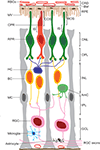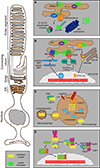The cell stress machinery and retinal degeneration
- PMID: 23684651
- PMCID: PMC4471140
- DOI: 10.1016/j.febslet.2013.05.020
The cell stress machinery and retinal degeneration
Abstract
Retinal degenerations are a group of clinically and genetically heterogeneous disorders characterised by progressive loss of vision due to neurodegeneration. The retina is a highly specialised tissue with a unique architecture and maintaining homeostasis in all the different retinal cell types is crucial for healthy vision. The retina can be exposed to a variety of environmental insults and stress, including light-induced damage, oxidative stress and inherited mutations that can lead to protein misfolding. Within retinal cells there are different mechanisms to cope with disturbances in proteostasis, such as the heat shock response, the unfolded protein response and autophagy. In this review, we discuss the multiple responses of the retina to different types of stress involved in retinal degenerations, such as retinitis pigmentosa, age-related macular degeneration and glaucoma. Understanding the mechanisms that maintain and re-establish proteostasis in the retina is important for developing new therapeutic approaches to fight blindness.
Copyright © 2013 Federation of European Biochemical Societies. Published by Elsevier B.V. All rights reserved.
Figures


Similar articles
-
Misfolded proteins and retinal dystrophies.Adv Exp Med Biol. 2010;664:115-21. doi: 10.1007/978-1-4419-1399-9_14. Adv Exp Med Biol. 2010. PMID: 20238009 Free PMC article. Review.
-
ER stress in retinal degeneration: a target for rational therapy?Trends Mol Med. 2011 Aug;17(8):442-51. doi: 10.1016/j.molmed.2011.04.002. Epub 2011 May 27. Trends Mol Med. 2011. PMID: 21620769 Review.
-
Aberrant protein trafficking in retinal degenerations: The initial phase of retinal remodeling.Exp Eye Res. 2016 Sep;150:71-80. doi: 10.1016/j.exer.2015.11.007. Epub 2015 Nov 26. Exp Eye Res. 2016. PMID: 26632497 Free PMC article. Review.
-
Structural abnormalities of retinal pigment epithelial cells in a light-inducible, rhodopsin mutant mouse.J Anat. 2023 Aug;243(2):223-234. doi: 10.1111/joa.13667. Epub 2022 Apr 15. J Anat. 2023. PMID: 35428980 Free PMC article.
-
Retinal Ganglion Cell Death as a Late Remodeling Effect of Photoreceptor Degeneration.Int J Mol Sci. 2019 Sep 19;20(18):4649. doi: 10.3390/ijms20184649. Int J Mol Sci. 2019. PMID: 31546829 Free PMC article. Review.
Cited by
-
Losing, preserving, and restoring vision from neurodegeneration in the eye.Curr Biol. 2023 Oct 9;33(19):R1019-R1036. doi: 10.1016/j.cub.2023.08.044. Curr Biol. 2023. PMID: 37816323 Free PMC article. Review.
-
Divergent Effects of HSP70 Overexpression in Photoreceptors During Inherited Retinal Degeneration.Invest Ophthalmol Vis Sci. 2020 Oct 1;61(12):25. doi: 10.1167/iovs.61.12.25. Invest Ophthalmol Vis Sci. 2020. PMID: 33107904 Free PMC article.
-
Molecular Determinants of Mitochondrial Shape and Function and Their Role in Glaucoma.Antioxid Redox Signal. 2023 May;38(13-15):896-919. doi: 10.1089/ars.2022.0124. Epub 2023 Jan 5. Antioxid Redox Signal. 2023. PMID: 36301938 Free PMC article. Review.
-
Aggregation of rhodopsin mutants in mouse models of autosomal dominant retinitis pigmentosa.Nat Commun. 2024 Feb 16;15(1):1451. doi: 10.1038/s41467-024-45748-4. Nat Commun. 2024. PMID: 38365903 Free PMC article.
-
Wild-type opsin does not aggregate with a misfolded opsin mutant.Biochim Biophys Acta. 2016 Aug;1858(8):1850-9. doi: 10.1016/j.bbamem.2016.04.013. Epub 2016 Apr 23. Biochim Biophys Acta. 2016. PMID: 27117643 Free PMC article.
References
-
- Masland RH. The fundamental plan of the retina. Nat. Neurosci. 2001;4:877–886. - PubMed
-
- Strauss O. The retinal pigment epithelium in visual function. Physiol Rev. 2005;85:845–881. - PubMed
-
- Kamermans M, Spekreijse H. The feedback pathway from horizontal cells to cones. A mini review with a look ahead. Vision Res. 1999;39:2449–2468. - PubMed
Publication types
MeSH terms
Substances
Grants and funding
LinkOut - more resources
Full Text Sources
Other Literature Sources

